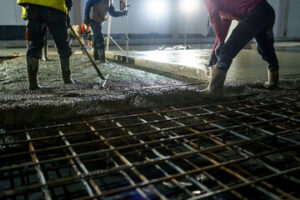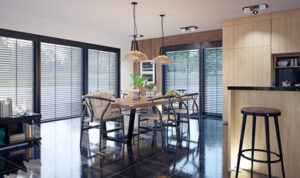Concrete Greensboro NC is a composite material created by mixing binding materials, aggregates, water and chemical additives. The result is a rock-like mass that can be used in many construction projects.

A person can buy dry ready mix concrete that comes pre-mixed, saving time and effort on a job site. It is typically brought to the job site in a concrete truck.
Concrete is one of the most durable building materials available and offers a high level of protection from extreme weather conditions and earthquakes. It is also incredibly versatile, allowing designers to create everything from curved walls to polished (and even luminescent) floors.
Unlike steel, which must be cut and bent into shape, concrete can be easily molded to take on any form needed. This versatility makes it a popular choice for commercial construction projects as architects can use it to create bespoke buildings that meet the specific needs of their clients.
Traditional concrete is a mixture of cement, water and aggregates (such as sand or gravel). Concrete with added reinforcement such as fibres or welded wire mesh is known as reinforced concrete (RCC). This gives it much higher tensile strength and makes it suitable for load bearing walls and foundations. RCC can be used in commercial construction projects of any size, from small warehouses to skyscrapers.
The strength of concrete means that it can be built to withstand large amounts of pressure, which makes it an ideal choice for large structures such as dams and bridges. The Grand Dixence Dam in Switzerland, for example, took 6 million cubic meters of concrete to construct and can withstand immense pressure without suffering from structural damage or failure.
Concrete’s excellent compressive strength works in harmony with its superior tensile strengths to create a powerful structural system, making it possible to build structures across huge distances and rise to impressive heights. In fact, the composite action of concrete and steel in reinforced concrete (RCC) has revolutionized construction, enabling engineers to build longer spans and taller buildings than ever before.
Despite its durability and strength, concrete is vulnerable to chemical attacks, particularly from acids such as sulphate and chloride. Acidic chemicals can penetrate the surface of the concrete, causing it to erode over time. This type of damage is a major problem in many industrial and marine settings, but can be avoided by using properly proportioned concrete with the right mix of cement, aggregates and water.
A well-proportioned concrete mix will ensure that the voids between aggregates are filled with the proper amount of cement, preventing them from becoming exposed and weakening the structure. Concrete can be strengthened further with the addition of steel reinforcement, which can help to prevent cracking and other forms of damage. This is essential in seismic zones where structures must withstand extreme loads, but is not required for standard building sites.
Durability
Concrete is incredibly durable, and it can last decades with little to no maintenance. This makes it a great choice for building structures that will be in use for a long time, such as bridges and roads. Unlike wood and metal, concrete is able to withstand the harshest weather conditions and can resist rusting or rotting. It can also withstand fires without deteriorating.
The durability of concrete is determined by its permeability, which affects the rate at which water or other fluids penetrate into it. The lower the permeability, the better its durability. To ensure the permeability of concrete is low, it must be compacted tightly to avoid air bubbles that could cause it to fail. It must also contain aggregates that are strong and inert-type. It must also be free of alkalis, chlorides and silt.
Other factors that influence the durability of concrete include freeze-thaw cycles, chemical attack and sulfate attacks. The permeability of concrete can be reduced by adding additives such as polymers, which also increases its strength. It is also important that concrete be placed in a controlled environment to control temperature and humidity to prevent premature deterioration.
While it is difficult to predict how long a structure will last, regular inspections can help identify any signs of wear and tear and potential structural problems. These issues can then be addressed early before they turn into serious failures. Regular maintenance can also help extend the lifespan of a concrete structure, helping to reduce its total cost of ownership.
Aside from its strength and durability, concrete is a cost-effective and environmentally friendly material to use in construction projects. It can help reduce a project’s energy costs, as it is an insulator that keeps buildings warm during the winter and cool in the summer. It also has the ability to store energy, reducing heating and cooling demands over its lifetime by up to 8%.
Many of the world’s most cherished historical sites and monuments are made from concrete, which is testament to its longevity. Understanding and applying principles of concrete durability can help preserve these cultural legacies for future generations and enable us to create cities that are safer, more efficient, and more beautiful.
Ease of Maintenance
Concrete is one of the most popular construction materials for both residential and commercial structures. It is found in homes, office buildings, shopping centres and transport infrastructure such as bridges, roads, tunnels and airports. It is a strong, durable and economical material that can be formed into a wide variety of shapes, providing both structural support and visual appeal. Its stability and durability means that it requires less maintenance than other building materials, saving money and time in the long run.
Concrete’s resistance to corrosion and weathering makes it an ideal construction material, as it can withstand harsh environmental conditions that would damage other materials over time. Combined with its durability and strength, these characteristics make it an ideal construction material for load-bearing structures such as buildings and skyscrapers. Concrete can be reinforced with steel bars or meshes to increase its tensile and shear strength, making it capable of handling both compression and bending stresses.
In addition to its durability and corrosion resistance, concrete has excellent fire-resistance, meaning that it can maintain its integrity in a fire for several hours, giving residents and workers time to escape the structure before it collapses. Concrete’s fire resistance also reduces maintenance costs, as it eliminates the need for additional fireproofing measures.
Another benefit of concrete is that it can be poured in any shape, allowing contractors to create complex architectural designs, such as curved walls and domes. Reinforced concrete can also be molded into limitless variations in texture, and decorative concrete techniques such as stamping and staining allow for a variety of aesthetic options.
Concrete has a high thermal mass, which helps to keep structures warm and reduces energy costs in colder climates. Concrete can also be insulated to further reduce energy costs and improve the comfort of homes and commercial buildings. Concrete is also an environmentally friendly building material because it can be produced anywhere in the world using local materials, minimizing shipping and pollution.
In addition, concrete is highly durable and lasts many years, reducing the need for replacement or reconstruction. In the future, innovative developments in concrete technology may further reduce maintenance and repair costs. For example, self-healing concrete is in development that uses bacteria to fill and heal cracks in the concrete, significantly reducing maintenance costs.
Sustainability
Concrete is a sustainable building material, leaving behind only a small environmental footprint. Concrete uses locally available raw materials and requires fewer resources to produce than many other types of construction materials. In addition, concrete structures can withstand the harshest weather conditions and most ferocious fires with relative ease. Concrete is also a durable product, lasting up to 100 years or more with minimal maintenance. This longevity and durability means fewer repairs, less waste, and a lower overall energy bill for the structure’s owner.
Using recycled aggregates, which are industrial byproducts and other waste materials that would otherwise be disposed of in landfills, reduces concrete’s environmental impact even further. In addition, a concrete mix can be adjusted to suit a particular project or construction schedule by adjusting the amount of cement, water, and aggregates used. Furthermore, a concrete structure can be easily deconstructed and the material recycled into new structures or reused in the form of crushed aggregates.
The concrete industry is currently working hard to mitigate a large percentage of the carbon emitted during production. Governments can accelerate this process by implementing green public procurement (GPP) policies, allowing them to use their purchasing power to drive demand for low-carbon cement and help the industry make this transition. Philanthropy can also play a critical role by supporting this effort.
In addition, concrete has a natural ability to absorb carbon dioxide from the atmosphere and turn it into a solid, which can offset some of the embodied emissions in its manufacture. This is a significant advantage over other construction materials, such as wood, which typically require extensive energy to process and burn into a usable substance.
For architects and builders looking to create more sustainable buildings, concrete is a great option. Its durability and long lifespan mean that buildings will need to be rebuilt less frequently, reducing operational energy needs and lowering resource consumption. Additionally, the thermal mass of concrete can help regulate indoor temperatures, further lowering energy requirements. Lastly, the fact that concrete is so simple to clean compared to other construction materials also helps with sustainability efforts.
